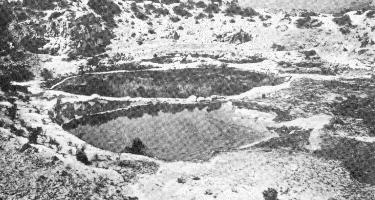HOWARD
HICKSON'S HISTORIES
[Index]
Soup's On!
Elko's Hot Hole
There's a place just north of Bullion Road
called the Hot Hole. It's fenced in because there have been some horrible
accidents there. The water is scalding.
Wagon trains stopped there long before Elko
existed and journals kept by travelers told of people being severely injured
or killed when they fell into the hot pool of water. Livestock were not
immune to its temperature and often died an appalling death by boiling.
Those knights of the railroad, the hoboes
(now unromantically dubbed transients), used to camp there regularly.
They, just like the pioneers passing through in 1840s and 1850s, rested
there, washed their clothes and draped them on sagebrush to dry, cooked
meals, slept on the bank, and some of the men shaved, enjoying one of the
few times when hot water was available for the chore.
Generally, it was a good place to stop and
rest if care was taken not to fall into the water.

Hot Hole, Elko, Nevada - Photograph courtesy of the
Nevada Historical Society, Reno.
In the Elko Free Press, February 8, 1896, an
article from a Texas newspaper was published. Written by reporter Francis
Fox, who had some of the facts confused, here is the story:
"The free soup houses might have been
dispensed with during the hard times if the people of Nevada had only put
barrels of the chicken soup that bubbles from the foothills of the Sierra
Nevadas (Editor: Ruby Mountains, not the Sierra) in Elko County, Nevada,
and dispatched it to the poor of our great cities.
"Incredible as it may seem, it is nevertheless a fact that soup
is a natural product; and I have often satisfied my hunger from this boiling
hot spring, which, judging by the palate, is simply nature's hot soup tureen.
"The pool, scarcely 100 yards in diameter, lies just off the
stage road among the foothills of the Sierra Nevada mountains (There, he
did it again. That mountain range is 300 miles to the west.) The traveler
comes on it just after crossing a toll bridge over the Humboldt River,
which rushes like a cataract through the Humboldt Valley far below, making
Chicken Soup Spring seem rather insignificant; but in reality this wonderful
little body of water has been sounded at a depth of 1200 feet while the
turbulent waters below are shallow in comparison. (The Humboldt a cataract?
The author must have something stronger than chicken soup when he penned
this story.)
"The south side of the pool is the deepest,
and seems to be the source from which the peculiar solution flows; for
the bubbling, boiling water on that side will cook a goose egg in two minutes.
It is a common sight to see tourists wending their way with bags of crackers
and cups in their hands.
"The neighboring road bed is ballasted
on one side by what appears to be a covering of hardened lime, but is in
reality pure crushed lava of unmistakably volcanic origin, for lying in
close proximity are evidences of volcanic eruption.
"The pool has been dragged many times,
but nothing has ever been taken from its depths but cedar. Cedar trees
once abounded in that locality, and the bark, which bears marks of considerable
age, was probably thrown in by the Indians while building their rafts and
canoes.
"This wonderful freak, lying about three
and a half miles from the tough little mining town of Elko (railroad town),
is never visited by the inhabitants unless they are passing that way and
feel hungry. The miners and rest of the matter of fact population have
long ceased to wonder at nature's partiality, and accept the existence
of this boiling soup caldron as a convenient fact. Whether it is due to
the mineral properties of the soil, or to the close proximity of lava beds,
or is itself a volcano in a mild state of aqueous eruption. I know not.
But there it is; and anyone who will go to Elko can easily find the spring
and sample the soup to corroborate my statements."
Francis Farmer you were full of hogwash,
not soup. Perhaps you were attempting to be another Mark Twain but his
twisted closeness of Elko and the Sierra Nevada booted him right out of
Twain's playing field.
A serious word of caution. The Hot Hole
is still there. Be very careful if you ever stop to look at the place.
It is a deadly body of scalding water.
Howard Hickson
November 19, 2000
Source: The original research was done by Claudia Riordan who lives
on a ranch near Jiggs. She was the Researcher at the Northeastern Nevada
Museum when the article was published in the Northeastern Nevada Historical
Society Quarterly, Summer, 1978.
©Copyright 2000 by Howard Hickson. If any portion
or all of this article is used or quoted proper credit must be given to
the author.
[Back to Hickson's Histories Index]
|